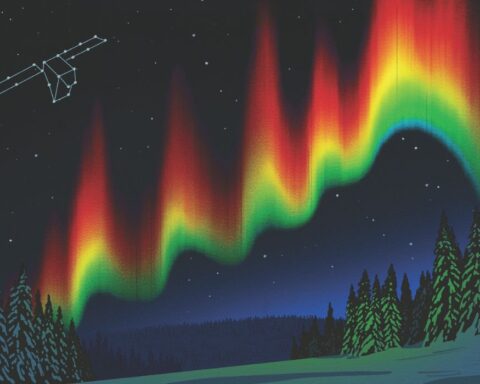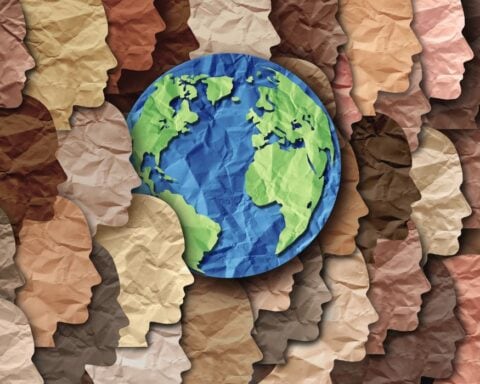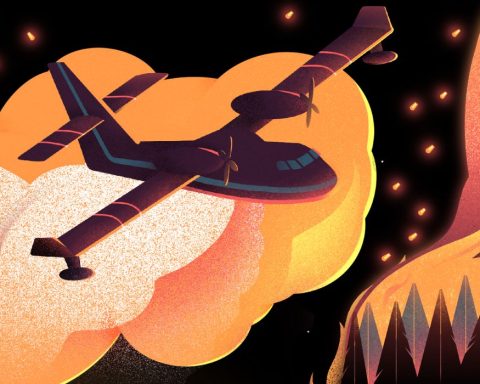In 1983, a French oceanographic research institute invited an invader to the country’s northern shores. The Japanese seaweed wakame, which grows in fettuccine-like ochre ribbons, had already made itself at home on the French Mediterranean coast after hitching a ride on an oyster boat from Asia in the 1970s. But the decision to introduce this foreign breed of kelp to three islands off the coast of Brittany was made with the intention of farming it as a commodity.
Researchers from IFREMER (Institut Français de Recherche pour l’Exploitation de la Mer) found that the wakame had colonized a nearby mussel farm in 1987. In the years that followed, it had taken over parts of the northern Atlantic coast of Spain, England’s southern coast, and the Channel Islands. By the turn of the century, the invasive variety of brown kelp had expanded its territory all the way up to the Netherlands.
This is kind of a worst-case scenario of seaweed cultivation: a farmed species takes over the ecosystem and transforms the native forests, disrupting all kinds of organisms that depend on them. As the seaweed aquaculture industry develops up and down the coasts of North America, state and provincial governments have passed strict laws to prevent the introduction of invasive species like Japanese wakame to our waters. But scientists and regulators are still trying to understand how cultivated and wild seaweed populations interact with each other – and how much we need to protect the latter.
Wild seaweed harvesting has been a tiny, niche industry in North America for decades, driven largely by boutique and health food purveyors and experimental chefs. But about six or seven years ago, Maine harvester Micah Woodcock noticed an explosion in interest in farming seaweed, with new businesses making dual claims of saving the planet and feeding the world. He never anticipated how trendy his product would become. “But I am not the biggest cheerleader for some of the large-scale seaweed projects going on,” he says.
Concerns shared by several ocean conservationists, ecologists and harvesters stem from the failures of agriculture on dry land. The fear is that mammoth seaweed farms will mimic the sprawling fields of wheat, corn and soy that have eroded the ecosystems of the North American prairies. But where is the ostensible seaweed boom – and the demand for such mammoth farms – coming from?
Seaweed the ‘wonder crop’
Seaweed is a bafflingly versatile ingredient, and it’s cropping up everywhere: from the snack aisles of Whole Foods to expensive moisturizers at Sephora. Asian producers dominate the global seaweed farming industry, at about 98% of the estimated US$9.9-billion market. That’s largely because East Asian diets include a lot of seaweed. And even though North American interest in alaria algae, sugar kelp and dulse has taken off, it’s still nowhere near the demand of Japanese, Chinese or Korean markets.
Meanwhile, North American mariculture operations have gotten tens of millions in funding from venture capital and governments in just the past few years. That’s because seaweed has a wide variety of purposes beyond the culinary: its ability to be put to work as a low-carbon ingredient of biofuels, bioplastics and fertilizers; its role as a methane-reducing cattle feed; and perhaps most of all, as government subsidies for carbon credits expand, its “blue carbon” potential to sequester emissions.
But seaweed’s entry into carbon markets is still pretty tentative. The theory behind kelp as a carbon sink is akin to the idea that a billion trees can save us from climate change: the logic is there, but the implementation is lacking. Seaweed grows very quickly – much, much faster than a tree – and its rapid photosynthesis eats up carbon with the appetite of a teenage boy. But the scale at which seaweed would have to be grown to achieve meaningful carbon sequestration would require millions of square kilometres of farms, according to a 2023 Nature study. And there may be unintended consequences on neighbouring ecosystems.
“You might be in for some nasty surprises,” says Louis Druehl, a veteran seaweed scientist and “kelp godfather” on Vancouver Island. As a crop, seaweed’s real environmental benefits come from its ability to neutralize acidifying waters and sequester nitrogen, both of which protect a litany of ocean creatures from the harms of climate change and industrial runoff.
Kelp has also been touted as a crop that can boost coastal economies that have suffered from overfishing, pollution and warming waters. That argument has been largely applied to Indigenous aquaculturists in North America’s Pacific Northwest, some of which are diversifying shellfish farms threatened by acidification by adding kelp to their growing operations. One of those is the Klahoose First Nation, which manages several shellfish farms around Cortes Island, B.C. The community recently partnered with Cascadia Seaweed, a buzzy Vancouver Island–based B Corp that has raised millions of dollars on its promise of seaweed aquaculture as a climate solution.
Small price to pay?
Seaweed farmers say that there’s a gaping chasm between the scale at which the industry poses a threat to wild ecosystems and how it functions today. Cascadia, for example, is the largest brown-seaweed farmer in Canada, at about 25 hectares of production.
“There’s a debate between conservationists and speculators: what happens to genetic diversity on these thousand-acre farms?” says Bren Smith, who operates a seaweed and shellfish farm in Connecticut and founded the non-profit GreenWave to educate other ocean farmers in the region to grow seaweed sustainably. “The rest of us farming are like, ‘What are you guys talking about?’ That’s the fictional stage. And we’re all operating in nonfiction – we’re trying to figure this out in the water, as wild kelp forests are dying around the world.”
Current regulations require that American seaweed farms grow their crops from wild native specimens, like sugar kelp in New England and bull kelp in Alaska. Divers collect tissue from native stocks around the site of the farm, and seeds from those samples are then cultivated into spores and planted on ropes underwater.
This practice was developed in part because of the research of Charles Yarish, who was one of the first American scientists to study the potential for seaweed aquaculture – and how to avoid introducing potentially harmful strains to wild stocks. “We started doing the genetics of populations of seaweeds in southern New England, and also in the Gulf of Maine,” Yarish says. “And we found out there are genetic differences between the populations, so we don’t mix them. We want to be very, very careful and respect the environment.”
Genetic diversity in wild populations is what keeps them resilient to disease, pollution, and warming or acidifying water, and cultivated seaweed populations – much like other farmed crops – tend to be more homogeneous. The conservationist concern is whether spores from cultivated plants could float off and reproduce among wild strands and weaken the resilience of native stocks.
Druehl participated in a literature review to find evidence of farmed seaweed contaminating the gene pool of its wild brethren in Maine. While there’s no recorded case of this contamination occurring, he says there’s no reason to assume it couldn’t happen.
“I think the problems will be quite small and very easy to mitigate,” Druehl says.
Alaska, for example, requires farmers to take seeds from 50 different plants within 50 kilometres of a farm, specifically to protect genetic diversity. But some of seaweed farming’s more enthusiastic proponents have argued that this kind of stringent regulation hinders the growth of the industry.
You might be in for some nasty surprises.
-Louis Druehl, a veteran seaweed scientist
Furthermore, there’s a complicating factor to propagating kelp from seed taken from the wild: native forests are collapsing and migrating as their home waters warm. One possible solution is the development of seed banks to preserve native specimens that farmers can use to propagate crops. Publicly owned seed banks could help the seaweed industry evade the threat of monoculture
farming, where corporations control the supply of seed to farmers.
They also offer the opportunity for a development that could raise some alarm bells for the conservation contingent: selectively bred kelp for farms. Yarish has helped to orchestrate a germplasm collection – bits of seed and tissue from different species and strains of seaweed – that researchers at the Woods Hole Oceanographic Institution, the University of Connecticut and the Bigelow Laboratory for Ocean Sciences will use to sequence and breed for resilient crops.
“We can see the impacts on the native populations,” Yarish says, “and we haven’t detected any negative impact.”
The landscape of seaweed farming showcases a very familiar debate in climate mitigation and adaptation about how much we should leave truly wild and how much we should help nature along. And, ultimately, do we have to choose between reducing carbon emissions and protecting the integrity of certain ecosystems?
“There might be a small price to pay along the coast to resolve the bigger problem – would you be willing to make that trade-off?” says Druehl.
Eve Andrews is an environmental journalist based in Pittsburgh.





